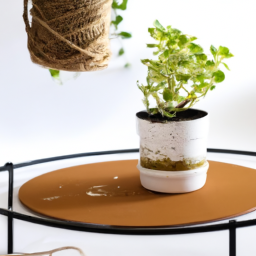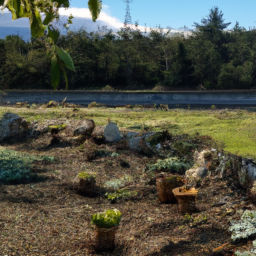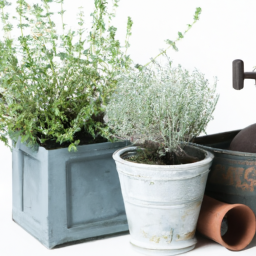
The Art of Repurposing: Transforming Vintage Items into Unique Planters
Repurposing vintage items into unique planters is a creative and sustainable way to add character and charm to your indoor or outdoor space. Not only does it give new life to forgotten objects, but it also allows you to showcase your personal style and create one-of-a-kind plant displays. In this guide, we will explore the art of repurposing and provide you with step-by-step instructions on how to turn vintage finds into stylish containers for your beloved plants.
Finding the Perfect Vintage Item
The first step in creating unique planters is to find the perfect vintage item to repurpose. This can be an exciting treasure hunt, as you never know what hidden gems you might discover. Here are a few places to start your search:
Flea Markets and Thrift Stores: Flea markets and thrift stores are a goldmine for vintage items. Look for old buckets, tin cans, wooden crates, teapots, or even discarded furniture pieces like chairs or dressers that can be transformed into planters.
Online Marketplaces: Online marketplaces, such as eBay or Etsy, offer a wide range of vintage items that can be repurposed into planters. You can browse through various categories like kitchenware, home decor, or garden accessories to find unique pieces.
Family Heirlooms and Attics: Explore your own attic or ask family members if they have any vintage items they no longer need. You might stumble upon old watering cans, ceramic pots, or decorative bowls that can be repurposed into stunning planters.
Preparing the Vintage Item
Once you have found the perfect vintage item, it’s time to prepare it for its new life as a planter. Here are the steps to follow:
Cleaning: Start by thoroughly cleaning the vintage item to remove any dirt, dust, or grime. Use mild soap and water, and gently scrub the surface with a soft brush or sponge. If the item is delicate or has intricate details, be extra careful to avoid damaging it.
Drainage: Most plants require proper drainage to thrive, so it’s essential to create drainage holes in your vintage planter. If the item already has holes, ensure they are clear and not clogged. For items without drainage holes, use a drill or hammer and nail to create a few holes at the bottom.
Sealing: Depending on the material of the vintage item, you may need to seal it to protect it from water damage. For example, if you repurpose a wooden crate or a porous ceramic pot, apply a waterproof sealant or a few coats of varnish to prevent water absorption.
Choosing the Right Plants
Now that your vintage item is clean and prepared, it’s time to choose the perfect plants to complement its unique character. Consider the following factors:
Size and Scale: Take into account the size and scale of the vintage item when selecting plants. For larger items like dressers or barrels, opt for taller plants or cascading vines. Smaller items like teacups or tin cans work well with small succulents or herbs.
Light Requirements: Assess the lighting conditions in the area where you plan to display your vintage planter. Choose plants that thrive in the available light, whether it’s full sun, partial shade, or low light.
Watering Needs: Different plants have different watering needs. Ensure that the plants you choose have similar water requirements to avoid over or under-watering. Additionally, consider the drainage capabilities of your vintage planter to prevent waterlogged roots.
Planting and Displaying
With your vintage item cleaned, prepared, and the perfect plants selected, it’s time to bring it all together. Here’s how to plant and display your unique planter:
Soil and Planting: Fill your vintage planter with a well-draining potting mix suitable for the chosen plants. Gently remove the plants from their nursery pots, loosen the roots, and place them in the planter. Add more soil around the plants, ensuring they are firmly in place.
Arrangement and Styling: Experiment with different arrangements and combinations of plants within your vintage planter. Consider height, color, and texture to create an aesthetically pleasing display. You can also add decorative elements like rocks, moss, or small figurines to enhance the overall look.
Placement: Choose the perfect spot to display your unique planter. Whether it’s a sunny windowsill, a cozy corner of your patio, or a prominent spot in your living room, make sure the plants receive the appropriate amount of light and are easily accessible for watering and maintenance.
By following these step-by-step instructions, you can transform vintage finds into stylish containers that breathe new life into your plant collection. Embrace the art of repurposing, unleash your creativity, and enjoy the beauty of unique planters that tell a story of their own.
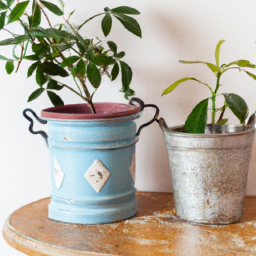
Stylish and Sustainable: Using Vintage Finds as Eco-Friendly Plant Containers
When it comes to adding a touch of uniqueness and charm to your indoor or outdoor space, nothing beats using vintage finds as plant containers. Not only do they bring character and style to your plantscape, but they also contribute to sustainable living by repurposing old objects and reducing waste. In this guide, we will explore the art of turning vintage finds into stylish planters, providing you with step-by-step instructions to create your own eco-friendly plant containers.
Finding the Perfect Vintage Container
The first step in creating unique planters is finding the perfect vintage container. This can be an exciting treasure hunt, as you search thrift stores, flea markets, and online marketplaces for hidden gems. Look for objects that catch your eye and have the potential to hold soil and plants. Some popular vintage finds for plant containers include old tin cans, vintage teapots, wooden crates, ceramic bowls, and even discarded furniture pieces like drawers or suitcases.
When selecting a vintage container, consider its size, material, and overall condition. Ensure that it is large enough to accommodate the root system of your chosen plants and has adequate drainage holes or the potential for you to add them. Avoid containers with lead-based paint or materials that may be toxic to plants. It’s also essential to inspect the vintage find for any cracks, chips, or damage that may impact its functionality as a planter.
Remember, the beauty of using vintage finds as plant containers lies in their imperfections and unique characteristics. Embrace the patina, weathering, or rust that may be present on these objects, as they add a sense of history and charm to your plant display.
Preparing the Vintage Container
Once you’ve found the perfect vintage container, it’s time to prepare it for its new life as a plant holder. Start by cleaning the object thoroughly, removing any dirt, dust, or debris that may have accumulated over time. Use mild soap and water for most materials, but be cautious when cleaning delicate or porous surfaces to avoid damage.
If your vintage find has any rust or chipped paint, you can consider giving it a fresh coat of paint or a protective sealant. Choose eco-friendly paint options that are safe for plants and the environment. This step not only enhances the aesthetics of the container but also helps preserve it for long-term use.
Next, assess the drainage situation of your vintage container. Proper drainage is crucial for plant health, as it prevents waterlogged soil and root rot. If your container doesn’t have drainage holes, you can create them yourself. Use a drill with a bit suitable for the material of the container and carefully make several small holes at the bottom. Alternatively, you can add a layer of gravel or small rocks at the bottom of the container to improve drainage.
Planting and Displaying in Vintage Containers
Now that your vintage container is clean and prepared, it’s time to transform it into a stylish planter for your beloved plants. Start by filling the container with a high-quality potting mix suitable for the types of plants you intend to grow. Consider the specific needs of your plants, such as moisture retention or drainage requirements, and choose a potting mix accordingly.
Once the container is filled with potting mix, create a suitable environment for your plants by making sure they have enough space to grow and thrive. Place your plants strategically, considering their size, growth habits, and light requirements. You can mix different types of plants in one container to create an eye-catching display, but ensure they have compatible needs to avoid overcrowding or competition for resources.
After planting, water your new vintage planter thoroughly, allowing the water to drain through the holes. Monitor the moisture levels regularly and water as needed, taking care not to overwater and drown the plants. Remember that different plants have different watering requirements, so it’s essential to research and understand the needs of your specific plant species.
Finally, find the perfect spot to display your vintage planter. Whether it’s indoors or outdoors, ensure that your plants receive adequate sunlight or shade according to their preferences. Consider the overall aesthetic of your space and how the vintage container contributes to the ambiance. You can place it on a windowsill, hang it from a hook, or create a unique arrangement with multiple vintage planters.
By using vintage finds as plant containers, you not only add a touch of style and uniqueness to your space but also contribute to sustainable living by repurposing old objects. So, go ahead and embark on your journey of turning vintage finds into stylish and eco-friendly plant containers. Happy planting!
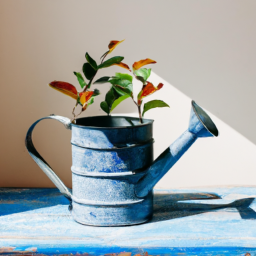
Unleashing Creativity: How to Make One-of-a-Kind Planters from Vintage Discoveries
Are you tired of using ordinary planters for your beloved plants? If you’re looking to add a touch of uniqueness and style to your indoor or outdoor garden, why not turn vintage finds into stunning plant containers? With a little creativity and some DIY skills, you can transform old and forgotten items into one-of-a-kind planters that will become the focal point of your green oasis. In this guide, we will explore the step-by-step process of creating unique planters from vintage discoveries, allowing you to unleash your creativity and give your plants a stylish home.
Finding the Perfect Vintage Item
The first step in turning vintage finds into stylish plant containers is finding the perfect item to repurpose. This is where your creativity comes into play, as the possibilities are endless. Visit flea markets, thrift stores, or even your own attic to discover hidden gems that can be transformed into planters. Look for items with interesting shapes, textures, and sizes that can accommodate the plants you have in mind. Vintage tea tins, old wooden crates, metal buckets, or even discarded furniture pieces can all be excellent choices for repurposing into unique planters.
Once you have found your vintage item, make sure it is clean and free from any dirt or debris. Depending on the material, you may need to sand, paint, or treat it to ensure its longevity as a planter. For example, if you have chosen a wooden crate, sanding it down and applying a protective sealant will help prevent rot and extend its lifespan.
Remember, the key is to choose a vintage item that speaks to you and complements your personal style. Don’t be afraid to think outside the box and experiment with unconventional objects – the more unique, the better!
Preparing the Vintage Item for Planting
Now that you have your vintage find ready, it’s time to prepare it for planting. Depending on the item, you may need to make some modifications to ensure proper drainage and create a suitable environment for your plants to thrive.
If your vintage item doesn’t already have drainage holes, you will need to create them. This can be done by using a drill with a suitable drill bit for the material. Be mindful of the size and number of holes you make, as it will affect the water drainage. Additionally, consider placing a layer of small rocks or broken pottery pieces at the bottom of the planter to further aid in drainage and prevent waterlogging.
Once the drainage is taken care of, you can add a layer of potting soil to the planter. Depending on the size of the vintage item, you may need to fill it partially or completely with soil. Ensure that the soil is of good quality and suitable for the plants you intend to grow. If your vintage planter is particularly large, you can also use a combination of potting soil and other materials such as perlite or vermiculite to create a lighter mix.
Before planting your chosen greenery, it’s essential to consider the specific needs of the plants. Some plants require more sunlight, while others prefer shade. Take into account the location where you plan to display your vintage planter and choose plants accordingly. Additionally, consider the size and growth habits of the plants to ensure they won’t outgrow the planter too quickly.
Displaying and Maintaining Your Unique Vintage Planters
Now that your vintage find has been transformed into a stylish planter and your plants are happily settled, it’s time to think about displaying and maintaining your unique creations.
When it comes to displaying your vintage planters, the options are vast. You can create a stunning arrangement by grouping multiple planters together, each with its own distinct charm. Hanging planters from the ceiling or arranging them on shelves can add a vertical element to your space. Alternatively, placing them on windowsills, tables, or even repurposing them as outdoor garden focal points can create a visually appealing display.
Maintaining your vintage planters is crucial to ensure the health and longevity of your plants. Regularly check the moisture levels in the soil and water accordingly. Remember that different plants have different watering needs, so it’s essential to research and understand the requirements of each species. Additionally, keep an eye out for any signs of pests or diseases, as early detection and treatment can prevent damage to your plants.
Lastly, don’t forget to periodically clean your vintage planters to remove any dust or debris that may accumulate over time. This will not only keep them looking their best but also prevent any potential harm to your plants.
In conclusion, turning vintage finds into stylish planters is a fantastic way to unleash your creativity and add a unique touch to your garden. By carefully selecting the perfect vintage item, preparing it for planting, and displaying and maintaining your creations, you can create one-of-a-kind plant containers that will be the envy of every gardening enthusiast. So, let your imagination run wild, and start transforming those vintage discoveries into stunning planters that will breathe new life into your green oasis.
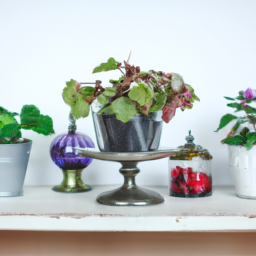
From Trash to Treasure: Turning Vintage Finds into Chic Plant Containers
Welcome to the world of unique planters, where vintage finds can be transformed into stylish containers for your beloved plants. In this guide, we will explore the art of repurposing old items and giving them a new life as chic plant containers. Get ready to unleash your creativity and create stunning displays that will add a touch of personality to any space.
Finding the Perfect Vintage Piece
The first step in turning vintage finds into stylish plant containers is finding the perfect piece to repurpose. Keep an eye out for unique items with interesting shapes, textures, and patterns. Thrift stores, flea markets, and online marketplaces are great places to start your search.
When selecting a vintage item, consider its size, material, and condition. Look for pieces that are sturdy enough to hold soil and plants, and ensure they have proper drainage. Avoid items that are damaged beyond repair or have toxic materials that could harm your plants.
Some popular vintage finds that can be repurposed as plant containers include old suitcases, wooden crates, metal buckets, ceramic bowls, and even discarded furniture like chairs or dressers. The possibilities are endless, so let your imagination run wild!
Preparing the Vintage Find
Once you’ve found the perfect vintage piece, it’s time to prepare it for its new life as a plant container. Start by cleaning the item thoroughly to remove any dirt, dust, or grime. Use mild soap and water for most materials, but be cautious with delicate items to avoid causing damage.
If the vintage find has any sharp edges or rough surfaces, sand them down to ensure the safety of your plants and yourself. You can also apply a coat of paint or varnish to protect the item and give it a fresh, updated look. Choose colors that complement your plants and the overall aesthetic you want to achieve.
Next, consider the drainage needs of your plants. If the vintage find doesn’t have drainage holes, you’ll need to create them. Use a drill with the appropriate bit size for the material or carefully hammer a few small holes in the bottom. Proper drainage is crucial to prevent waterlogging and root rot.
Planting and Styling your Vintage Planter
Now that your vintage find is clean and prepared, it’s time to turn it into a stylish plant container. Start by adding a layer of gravel or small rocks to the bottom, which will help with drainage and prevent soil from clogging the holes. Then, fill the container with a high-quality potting mix, leaving enough space for the plant’s roots.
Choose plants that are suitable for the size and conditions of your vintage planter. Consider the amount of sunlight the container will receive and the specific needs of the plants you want to grow. Succulents, herbs, and small flowering plants are popular choices for vintage planters due to their adaptability and visual appeal.
When planting, be mindful of the overall composition and balance. Place taller plants in the back or center, and cascading or trailing plants towards the edges. Experiment with different textures, colors, and heights to create an eye-catching arrangement that showcases the beauty of both the plants and the vintage container.
Remember to water your plants regularly, but be cautious not to overwater. Vintage containers may require more frequent watering than traditional pots, as they can dry out faster. Monitor the moisture levels and adjust your watering schedule accordingly.
Finally, find the perfect spot to display your unique planter. Whether it’s a sunny windowsill, a cozy corner, or a statement piece in your garden, let your vintage find shine and become a conversation starter among your friends and guests.
Now that you have mastered the art of turning vintage finds into stylish plant containers, the possibilities are endless. Explore your local thrift stores, flea markets, and your own attic to discover hidden treasures waiting to be repurposed. Embrace the charm of vintage, and let your plants thrive in their new chic homes!

5. Vintage Charm for Your Green Space: Creating Stylish Planters from Antique Pieces
Are you looking to add a touch of vintage charm to your green space? Why not turn antique pieces into stylish planters? This unique approach not only adds character to your garden but also repurposes old items, giving them a new lease on life. In this guide, we will take you through the step-by-step process of creating unique planters from vintage finds. So, let’s dive in and transform your garden into a captivating oasis!
Finding the Perfect Vintage Piece
The first step in creating stylish planters from antique pieces is finding the perfect vintage item to repurpose. Explore flea markets, thrift stores, and online marketplaces to discover unique finds that catch your eye. Look for items with interesting shapes, textures, and materials that can serve as a beautiful container for your plants.
Consider items such as old metal buckets, wooden crates, vintage teapots, or even discarded furniture like chairs or dressers. The possibilities are endless, so let your creativity run wild! Remember to choose items that are sturdy and can withstand outdoor conditions.
Once you’ve found your vintage piece, it’s time to prepare it for its new role as a planter. Clean the item thoroughly and remove any rust, dirt, or debris. Sand down rough edges and surfaces to create a smooth and safe environment for your plants.
Preparing the Vintage Piece for Planting
Now that you have your vintage find ready, it’s essential to prepare it for planting. Start by ensuring proper drainage to prevent waterlogging and root rot. Drill or punch holes in the bottom of your vintage container to allow excess water to escape.
Next, line the inside of your planter with a layer of landscape fabric or mesh. This barrier will prevent soil from falling out while still allowing water to drain freely. It also helps to retain moisture, ensuring your plants stay hydrated.
After lining the planter, fill it with a well-draining potting mix. Choose a high-quality mix that suits the specific needs of your plants. Consider adding organic matter like compost or peat moss to improve soil fertility and moisture retention.
Choosing the Right Plants for Your Vintage Planter
Now comes the fun part – selecting the perfect plants for your vintage planter! The choice of plants depends on various factors, including the size of the planter, the amount of sunlight it receives, and your personal preferences.
For larger vintage containers, you can opt for statement plants like tall grasses, small trees, or even climbing vines. These plants create a dramatic focal point and add vertical interest to your garden. Alternatively, you can create a charming herb or vegetable garden by planting a variety of culinary delights in smaller vintage containers.
Consider the light requirements of your chosen plants and place your vintage planter accordingly. Some plants thrive in full sun, while others prefer partial or full shade. Group plants with similar light needs together to ensure they thrive and create a visually pleasing arrangement.
Remember to water your plants regularly and provide them with the necessary care based on their specific needs. Vintage planters may require more frequent watering due to their materials and potential for faster evaporation.
In conclusion, turning vintage finds into stylish planters is a fantastic way to add character and a touch of nostalgia to your green space. By following these step-by-step guidelines, you can transform antique pieces into unique containers that showcase your plants beautifully. So, go out there, explore vintage markets, and let your creativity flourish as you create a garden filled with vintage charm!
Frequently Asked Questions (FAQ)
1. What are unique planters?
Unique planters refer to containers or pots that are creatively repurposed from vintage or unconventional items to hold plants. These planters add a distinctive and stylish touch to your indoor or outdoor space.
2. How can I turn vintage finds into stylish planters?
To turn vintage finds into stylish planters, you can start by selecting suitable items like old buckets, teapots, or even shoes. Clean and prepare the item, add drainage holes if necessary, and then fill it with soil and your desired plants. Finally, place the planter in an appropriate location for your plants to thrive.
3. What are the benefits of using unique planters?
Using unique planters can enhance the aesthetic appeal of your space by adding a touch of creativity and personality. They can also be great conversation starters and allow you to showcase your individual style. Additionally, repurposing vintage items as planters promotes sustainability and reduces waste.
4. Can any item be used as a planter?
While many items can be repurposed into planters, it’s essential to consider their suitability for holding plants. Items should be able to provide adequate drainage, be sturdy enough to support the plant’s growth, and not contain harmful substances that could leach into the soil.
5. How do I ensure proper drainage in unique planters?
To ensure proper drainage in unique planters, you can drill or create drainage holes in the bottom of the item. These holes allow excess water to escape, preventing waterlogging and root rot. It’s crucial to choose an appropriate size and number of drainage holes based on the planter’s dimensions and the plant’s needs.
6. What types of plants are suitable for unique planters?
A wide range of plants can thrive in unique planters, including succulents, herbs, small flowers, and even some vegetables. It’s important to consider the specific plant’s light, water, and space requirements to ensure it will flourish in the chosen planter.
7. How do I maintain unique planters?
Maintaining unique planters involves regular watering, appropriate fertilization, and monitoring for any signs of pests or diseases. Additionally, you may need to repot the plants as they grow or adjust their positioning based on their sunlight needs.
8. Can unique planters be used outdoors?
Yes, unique planters can be used both indoors and outdoors. However, it’s important to consider the durability of the material used for the planter and the specific weather conditions in your area. Some items may be more suitable for indoor use, while others can withstand outdoor elements.
9. Where can I find vintage items for repurposing as planters?
You can find vintage items for repurposing as planters in various places, such as flea markets, thrift stores, antique shops, or even online marketplaces. Keep an eye out for unique and interesting items that catch your attention and have the potential to be transformed into planters.
10. Are there any precautions I should take when using unique planters?
When using unique planters, it’s essential to ensure the item is clean and free from any harmful substances that could affect plant health. Additionally, be cautious of the weight of the planter and its stability to prevent accidents or damage. Regularly inspect the planter for any signs of deterioration or wear.

Lisa Chen is a seasoned indoor gardening expert and the author of several bestselling books on the topic. With a background in horticulture and urban farming, Lisa is dedicated to helping urban dwellers embrace the joys of cultivating green spaces indoors. Her detailed guides and hands-on tips empower readers to transform their living spaces into thriving plant sanctuaries.

